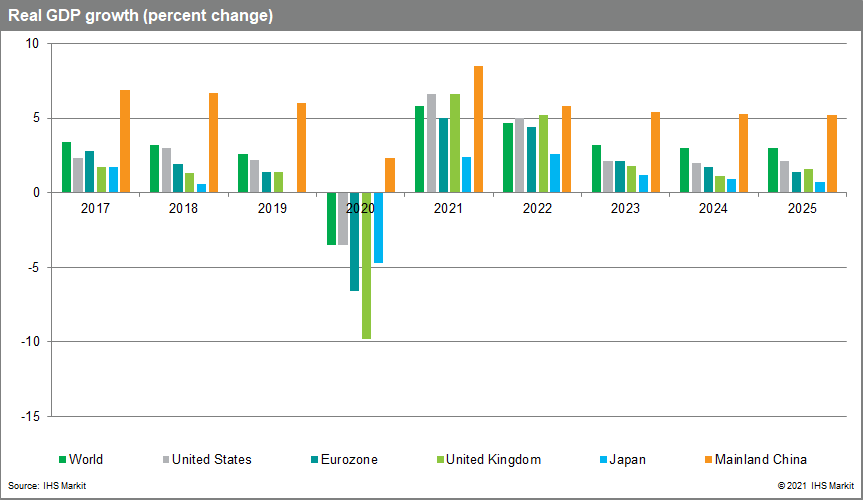Global economic growth depends increasingly on COVID-19 vaccination progress
The global economic expansion is proceeding, led by the United States, mainland China, and Europe. In 2021 and 2022, economic growth will be linked to COVID-19 vaccination progress. Countries with low vaccination rates face increased risks from the Delta variant of the virus, adding to the urgency of stepping up international vaccination campaigns. In countries that can safely reopen, the resilience of spending on services will deliver robust economic growth.

In the face of headwinds from the Delta variant of the COVID-19 virus, the global economic expansion is moving forward—albeit more tentatively than a month ago. Outlooks in advanced countries with high vaccination rates remain bright, but near-term prospects in emerging and developing countries with low vaccination rates are murkier. World real GDP has fully recovered from the harsh 9% contraction in the first two quarters of 2020, reaching a new peak in the second quarter of 2021. Economic growth will strengthen in the second half of 2021 led by consumer resilience in Europe and sustained dynamism in the United States. However, COVID-19 outbreaks in Asia-Pacific and Africa will constrain production and exports, prolonging global supply-chain disruptions.
After a 3.5% decline in 2020, global real GDP is projected to expand 5.8% in 2021 and 4.7% in 2022 owing to support from a staggered reopening of regional economies as the pandemic subsides. Growth will settle to 3.2% in 2023 as pent-up demands are satisfied and fiscal and monetary stimuli are withdrawn. The global growth forecast is revised down by 0.2 percentage point in 2021, when less robust prospects for Asia-Pacific and the United States are partially offset by brighter outlooks for Europe and Latin America. The 2021 setback to world output growth will be fully recoupled in 2022-23.
As economies reopen, services are taking the lead in driving growth.
The IHS Markit surveys of purchasing managers are showing a new buoyancy in service sectors, along with steady growth in manufacturing. In June, four of the five fastest-growing sectors were services: tourism and recreation, telecommunications, industrial services, and healthcare services. Consumer spending on services is proving surprisingly resilient as COVID-19 containment measures are lifted, travel picks up, and social activities resume. High-frequency data for the United States points to nearly full recoveries in restaurant dining, passenger air travel, and hotel revenues. However, lingering COVID-19 infections have kept many international travel restrictions in place, delaying economic recoveries in tourism-dependent countries.
The US forecast calls for less robust growth and higher inflation in 2021.
In the June forecast, US real GDP growth for 2021 is revised down from 7.4% to 6.6%. The revision is largely accounted for by weaker consumer and business spending in May. The recovery remains on solid footing owing to a nearly complete recission of pandemic containment measures, expansionary fiscal and monetary policies, and restocking of depleted inventories. Real GDP is projected to increase at upwardly revised rates of 5.0% in 2022 and 2.1% in 2023. Near-term price pressures will push consumer price inflation up to 3.7% in 2021 and 2.4% in 2022, prompting the US Federal Reserve to taper its asset purchases in 2022 and start raising the federal funds rate in 2023.
A vigorous rebound in consumer spending lifts western Europe's business outlook.
Leading indicators signal a brisk pick-up in economic activity across western Europe as consumer-facing services benefit from a major easing of COVID-19 restrictions. Consumer spending was hit hard by lockdowns but will now be the driving force in the recovery. Improving labor markets and household savings accumulated during the pandemic will support pent-up demand for services and nonessential goods. Surging eurozone business confidence also signals a revival in equipment investment, while construction investment continues to outperform. After a 6.6% decline in 2020, eurozone real GDP is projected to increase 5.0% in 2021, 4.4% in 2022, and 2.1% in 2023.
Asia-Pacific economies are struggling with new COVID-19 waves.
The spread of the highly transmissible Delta variant of the virus has resulted in renewed lockdowns in many countries, including Indonesia, Vietnam, Australia, Singapore, Malaysia, Thailand, Cambodia, and Myanmar. The situation is aggravated by the relatively slow progress of vaccination campaigns. Consumer spending, tourism, industrial production, and exports have been adversely affected. Production losses are disrupting global manufacturing supply chains, with shortages and lengthening delivery times adding to inflation pressures. Amid the region's pandemic-related setbacks, mainland China's economy has achieved robust growth. The country's real GDP is projected to increase 8.5% in 2021 and 5.8% in 2022, generating rising demand for the exports of its regional trading partners.
Emerging and developing countries face multiple challenges during and after the pandemic.
The Delta variant of the COVID-19 virus is taking a toll on emerging and developing countries where vaccine supplies are in short supply. Sub-Saharan Africa is experiencing a third wave of COVID-19 cases, resulting in new restrictions in South Africa, Namibia, Botswana, Zimbabwe, Mozambique, and Zambia.
The World Bank estimates that the pandemic will send 160 million people into poverty by the end of 2021. IHS Markit analysts project that 2021 unemployment rates will rise to 10.6% in developing countries and 8.0% in emerging markets (while falling to 5.9% in advanced countries). Progress in reducing unemployment will begin in 2022 as vaccinations increase and the pandemic subsides. In many of these countries, income losses are exacerbated by high consumer price inflation. The combination of rising inflation, currency depreciation, and capital flight has forced a number of emerging and developing countries to tighten monetary policies before achieving sustainable economic recoveries.